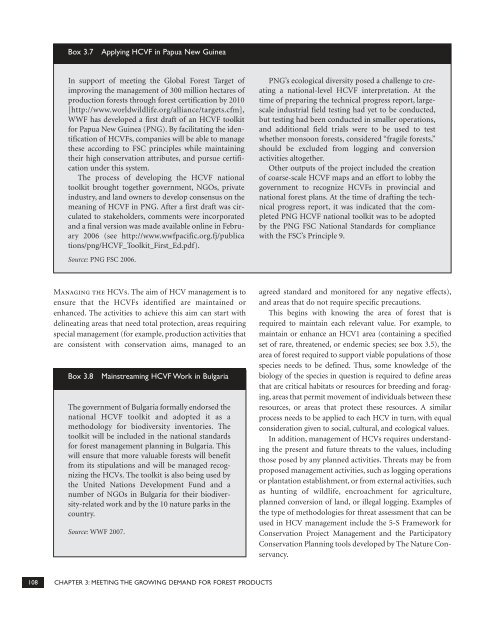Forests Sourcebook - HCV Resource Network
Forests Sourcebook - HCV Resource Network
Forests Sourcebook - HCV Resource Network
Create successful ePaper yourself
Turn your PDF publications into a flip-book with our unique Google optimized e-Paper software.
Box 3.7<br />
Applying <strong>HCV</strong>F in Papua New Guinea<br />
In support of meeting the Global Forest Target of<br />
improving the management of 300 million hectares of<br />
production forests through forest certification by 2010<br />
[http://www.worldwildlife.org/alliance/targets.cfm],<br />
WWF has developed a first draft of an <strong>HCV</strong>F toolkit<br />
for Papua New Guinea (PNG). By facilitating the identification<br />
of <strong>HCV</strong>Fs, companies will be able to manage<br />
these according to FSC principles while maintaining<br />
their high conservation attributes, and pursue certification<br />
under this system.<br />
The process of developing the <strong>HCV</strong>F national<br />
toolkit brought together government, NGOs, private<br />
industry, and land owners to develop consensus on the<br />
meaning of <strong>HCV</strong>F in PNG. After a first draft was circulated<br />
to stakeholders, comments were incorporated<br />
and a final version was made available online in February<br />
2006 (see http://www.wwfpacific.org.fj/publica<br />
tions/png/<strong>HCV</strong>F_Toolkit_First_Ed.pdf).<br />
PNG’s ecological diversity posed a challenge to creating<br />
a national-level <strong>HCV</strong>F interpretation. At the<br />
time of preparing the technical progress report, largescale<br />
industrial field testing had yet to be conducted,<br />
but testing had been conducted in smaller operations,<br />
and additional field trials were to be used to test<br />
whether monsoon forests, considered “fragile forests,”<br />
should be excluded from logging and conversion<br />
activities altogether.<br />
Other outputs of the project included the creation<br />
of coarse-scale <strong>HCV</strong>F maps and an effort to lobby the<br />
government to recognize <strong>HCV</strong>Fs in provincial and<br />
national forest plans. At the time of drafting the technical<br />
progress report, it was indicated that the completed<br />
PNG <strong>HCV</strong>F national toolkit was to be adopted<br />
by the PNG FSC National Standards for compliance<br />
with the FSC’s Principle 9.<br />
Source: PNG FSC 2006.<br />
Managing the <strong>HCV</strong>s. The aim of <strong>HCV</strong> management is to<br />
ensure that the <strong>HCV</strong>Fs identified are maintained or<br />
enhanced. The activities to achieve this aim can start with<br />
delineating areas that need total protection, areas requiring<br />
special management (for example, production activities that<br />
are consistent with conservation aims, managed to an<br />
Box 3.8<br />
The government of Bulgaria formally endorsed the<br />
national <strong>HCV</strong>F toolkit and adopted it as a<br />
methodology for biodiversity inventories. The<br />
toolkit will be included in the national standards<br />
for forest management planning in Bulgaria. This<br />
will ensure that more valuable forests will benefit<br />
from its stipulations and will be managed recognizing<br />
the <strong>HCV</strong>s. The toolkit is also being used by<br />
the United Nations Development Fund and a<br />
number of NGOs in Bulgaria for their biodiversity-related<br />
work and by the 10 nature parks in the<br />
country.<br />
Source: WWF 2007.<br />
Mainstreaming <strong>HCV</strong>F Work in Bulgaria<br />
agreed standard and monitored for any negative effects),<br />
and areas that do not require specific precautions.<br />
This begins with knowing the area of forest that is<br />
required to maintain each relevant value. For example, to<br />
maintain or enhance an <strong>HCV</strong>1 area (containing a specified<br />
set of rare, threatened, or endemic species; see box 3.5), the<br />
area of forest required to support viable populations of those<br />
species needs to be defined. Thus, some knowledge of the<br />
biology of the species in question is required to define areas<br />
that are critical habitats or resources for breeding and foraging,<br />
areas that permit movement of individuals between these<br />
resources, or areas that protect these resources. A similar<br />
process needs to be applied to each <strong>HCV</strong> in turn, with equal<br />
consideration given to social, cultural, and ecological values.<br />
In addition, management of <strong>HCV</strong>s requires understanding<br />
the present and future threats to the values, including<br />
those posed by any planned activities. Threats may be from<br />
proposed management activities, such as logging operations<br />
or plantation establishment, or from external activities, such<br />
as hunting of wildlife, encroachment for agriculture,<br />
planned conversion of land, or illegal logging. Examples of<br />
the type of methodologies for threat assessment that can be<br />
used in <strong>HCV</strong> management include the 5-S Framework for<br />
Conservation Project Management and the Participatory<br />
Conservation Planning tools developed by The Nature Conservancy.<br />
108 CHAPTER 3: MEETING THE GROWING DEMAND FOR FOREST PRODUCTS

















